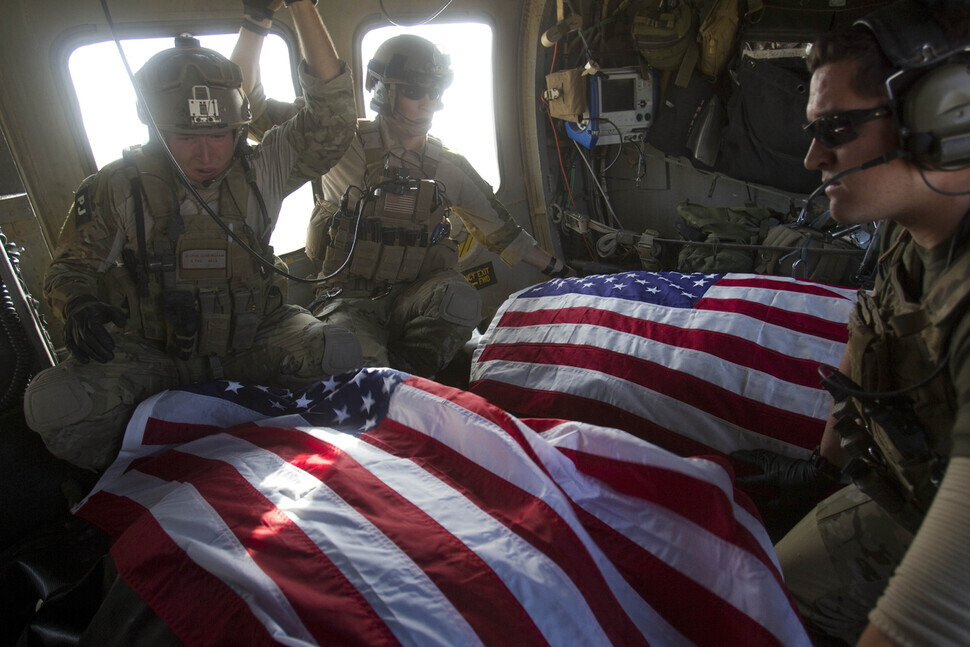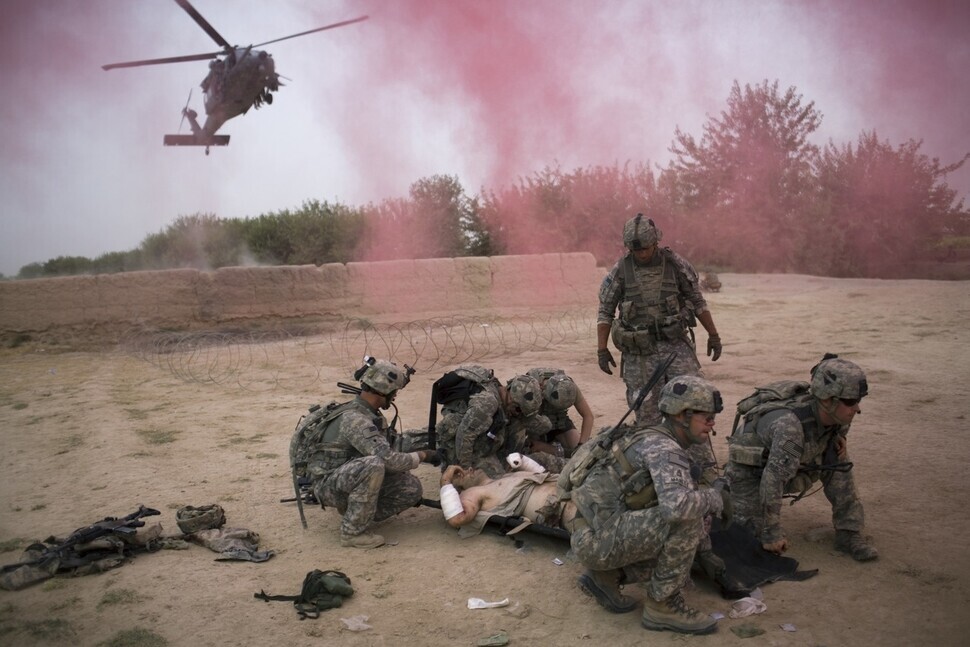hankyoreh
Links to other country sites 다른 나라 사이트 링크
[Column] Victory for Taliban and defense contractors, defeat for US

After dragging on for 20 years, the War in Afghanistan ended with the US’ defeat. The war was begun by US President George W. Bush in 2001 after the 9/11 terrorist attacks with the purpose of wiping out the Taliban, a group of Islamist militants who had harbored terrorists.
The US succeeded at capturing the Afghan capital of Kabul and setting up a new government, but the Taliban began to regroup after the US launched the Iraq War in 2003. The situation in Afghanistan worsened after 2005, and US casualties began piling up.
The fighting in Afghanistan involved sporadic skirmishes at small bases, attracting little attention from the press. The Bush administration agreed to pull out American troops from Iraq by the end of 2011, and the Iraq War ended with little accomplished.
A 20-year war sustained by liesAfter pledging to resolve the War in Afghanistan in the 2008 presidential campaign, US President Barack Obama sent 30,000 more troops to Afghanistan. Other NATO members boosted their troop presence and carried out major operations, but casualties increased without the situation improving.
In the end, NATO command decided to start withdrawing troops in 2012, and Obama promised to pull out American troops by 2014. The US left behind only enough troops to support the Afghan government forces in their continuing fight.
In February 2020, after 19 years of war, US President Donald Trump agreed to negotiate with the Taliban and reached a peace agreement under which US troops were supposed to be completely withdrawn by May 1, 2021. Afghanistan fell under the rule of the Taliban this August.
Some argue that the War in Afghanistan became the US’ longest war because the US government and the military command covered up the truth of the war.
“The Afghanistan Papers: A Secret History of the War,” which is being published by a Washington Post reporter following a long investigation, makes the bombshell claim that three US administrations, under Bush, Obama, and Trump, made a series of poor decisions about the War in Afghanistan and manipulated public opinion to paper over those mistakes.
Craig Whitlock, author of “The Afghanistan Papers,” argues that the Obama administration’s surge and the following pullout were both policy failures and that the Trump administration cynically hyped its deal with the Taliban as an agreement to end the war despite realizing that peace in Afghanistan was impossible. Whitlock’s book is likely to add more fuel to the debate about the US’ military failure.
The US government and military leadership’s deception of the public and continuation of the war enabled the US arms industry to flourish as never before.
The US’ top five defense firms, including Boeing and Lockheed Martin, saw their stock prices increase tenfold over the past two decades, while the S&P 500 index increased sixfold.
Boeing also produces civilian aircraft, but the other four defense firms depend upon the US government for most of their revenue. Given their size, these five firms effectively made up much of the boom in the US stock market over the past 20 years.
That brings us to the question of how the government could have deceived the public for so long about the war it was waging. One intriguing argument is that the American public lost interest in American wars after the US transitioned from the draft to a volunteer army after the Vietnam War, which ended in 1975. The Nixon administration abolished the draft after the anti-war movement convinced him that the war couldn’t be won after losing the “home front,” or in other words the battle for public opinion.
The Gulf War in 1991 was the first war that the US fought with a volunteer army. President George H.W. Bush, who had experienced the horrors of the battlefield during his service in World War II, brought the war to a quick and victorious conclusion. But his son, George W. Bush, failed to learn from his father and waged a protracted and wasteful “war on terror.”
But even as the war on terror dragged on and more American soldiers were killed, the fact that Americans weren’t being drafted meant that the only ones who cared about the war were the spouses, children, and parents of the soldiers being sent to the battlefield. That’s also why the US didn’t see the kind of anti-war protests that were so intense during the Vietnam War.

US service members who returned home from Afghanistan were often dismayed to learn that many other Americans didn’t even know the US military was still fighting in Afghanistan. The war was no longer on most Americans’ radar screen.
Interestingly enough, both Bill Ayers, an activist who formerly led protests against the Vietnam War, and Elliot Ackerman, a writer who fought in the wars in Iraq and Afghanistan, took issue with the volunteer army and lamented that only service members’ families were paying attention to the war.
“Lone Survivor,” a film about the War in Afghanistan, gave the impression that the war on terror was being fought by officers and NCOs in the special forces. But in reality, the servicemembers who fought in Afghanistan’s rugged hills were young people, often fresh out of high school.
Many young people who spent a troubled childhood in broken families signed up for the army because they were looking for an escape. The army provided a home for these young people as they embarked on a new life.
Unlike young people in the middle and upper classes, many of these service members only made friends and found a purpose in life when they joined the army. These young people bore the brunt of a war in which more than 2,400 service members died.
A few days ago, USA Today published a column by Steven Kerns, who took part in fierce fighting in the mountains of eastern Afghanistan in 2006-2007 and became a lawyer after leaving the military. Kerns, who dealt with the pain of losing comrades in battle, recalled that even those young soldiers didn’t see any chance of winning the War in Afghanistan.
Kerns said that the war was politically affordable because of the severe “civil-military divide” in American society.
Service members and their family members only account for 1 percent of the American population, and the actual fighting force only represents 10 percent of the entire military. Nevertheless, it’s this tiny portion of the population that must bear the heavy burden of US foreign policy. Kerns argues that the War in Afghanistan was a victory for the US arms industry and the Taliban, but a defeat for the US.
By Lee Sang-don, Professor Emeritus at Chung-Ang University
Please direct comments or questions to [english@hani.co.kr]

Editorial・opinion
![[Column] Season 2 of special prosecutor probe may be coming to Korea soon [Column] Season 2 of special prosecutor probe may be coming to Korea soon](https://flexible.img.hani.co.kr/flexible/normal/500/300/imgdb/original/2024/0426/3317141030699447.jpg) [Column] Season 2 of special prosecutor probe may be coming to Korea soon
[Column] Season 2 of special prosecutor probe may be coming to Korea soon![[Column] Park Geun-hye déjà vu in Yoon Suk-yeol [Column] Park Geun-hye déjà vu in Yoon Suk-yeol](https://flexible.img.hani.co.kr/flexible/normal/500/300/imgdb/original/2024/0424/651713945113788.jpg) [Column] Park Geun-hye déjà vu in Yoon Suk-yeol
[Column] Park Geun-hye déjà vu in Yoon Suk-yeol- [Editorial] New weight of N. Korea’s nuclear threats makes dialogue all the more urgent
- [Guest essay] The real reason Korea’s new right wants to dub Rhee a founding father
- [Column] ‘Choson’: Is it time we start referring to N. Korea in its own terms?
- [Editorial] Japan’s rewriting of history with Korea has gone too far
- [Column] The president’s questionable capacity for dialogue
- [Column] Are chaebol firms just pizza pies for families to divvy up as they please?
- [Column] Has Korea, too, crossed the Rubicon on China?
- [Correspondent’s column] In Japan’s alliance with US, echoes of its past alliances with UK
Most viewed articles
- 1AI is catching up with humans at a ‘shocking’ rate
- 2Korea’s 1.3% growth in Q1 signals ‘textbook’ return to growth, says government
- 3[Column] Park Geun-hye déjà vu in Yoon Suk-yeol
- 4[Column] Season 2 of special prosecutor probe may be coming to Korea soon
- 5No good, very bad game for Korea puts it out of Olympics for first time since 1988
- 6Marriages nosedived 40% over last 10 years in Korea, a factor in low birth rate
- 7Division commander ordered troops to enter raging flood waters before Marine died, survivor says
- 81 in 5 unwed Korean women want child-free life, study shows
- 9[Column] Has Korea, too, crossed the Rubicon on China?
- 10Will NewJeans end up collateral damage in internal feud at K-pop juggernaut Hybe?